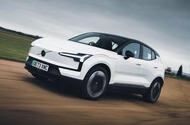Volvo is making waves in the electric vehicle (EV) market by shifting production of its EX30 model to Ghent, Belgium. This strategic move marks a significant change for the Swedish automaker, which previously relied solely on its facility in Zhangjiakou, China, to assemble this small SUV. By bringing production closer to its European customers, Volvo aims to enhance its responsiveness to local demand and navigate the complexities of international tariffs.
Why Move Production to Europe?
The decision to establish a production line in Ghent stems from a combination of market demand and regulatory challenges. The EX30 has quickly gained traction in Europe, ranking as the 13th best-selling EV in the region during the first quarter of 2025. This popularity is impressive, especially considering it outperformed established competitors like the Audi Q4 E-tron and the Mercedes-Benz EQA.
In October 2023, the European Union imposed punitive tariffs on Chinese-built electric vehicles, including the EX30. This regulatory shift prompted Volvo to rethink its production strategy. By manufacturing the EX30 in Belgium, the company can bypass these tariffs, ensuring that it remains competitive in the European market. Francesca Gamboni, Volvo’s chief manufacturing and supply chain officer, emphasized the importance of this model for the brand’s standing in Europe, stating that the production flexibility enhances the company’s resilience.
What Changes Were Made in Ghent?
The transformation of the Ghent plant to accommodate the EX30 was no small feat. Volvo invested €200 million (approximately £171 million) to set up a new assembly line, integrate 600 new or refurbished robots, and establish a battery pack production line. This investment not only supports the EX30 but also bolsters the production capabilities for other electric models like the EC40 and EX40, as well as hybrid vehicles such as the XC40 and V60.
The Ghent facility is now a hub for Volvo’s electric ambitions in Europe. By localizing production, the company can respond more swiftly to market changes and consumer preferences, which is crucial in the fast-evolving EV landscape.
What’s Next for the EX30?
Looking ahead, Volvo had initially planned to launch the EX30 in the U.S. after 2025. However, the ongoing discussions around tariffs, particularly the 25% tariff on all foreign-built cars proposed by the U.S. government, have created uncertainty about this timeline. While the company has yet to confirm its U.S. strategy, the focus remains on solidifying its position in Europe first.
The big takeaway? Volvo’s shift to local production isn’t just about logistics; it’s a strategic play to enhance competitiveness in a rapidly changing market. By making these adjustments, Volvo is not only positioning the EX30 for success in Europe but also setting a precedent for how automakers can adapt to global challenges. If you’re considering an electric vehicle, keep an eye on how these developments unfold—it could influence your next purchase decision!

